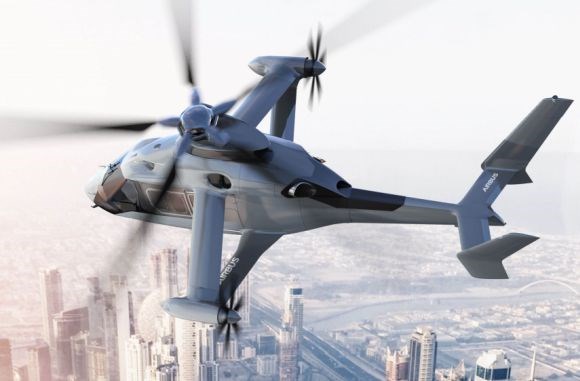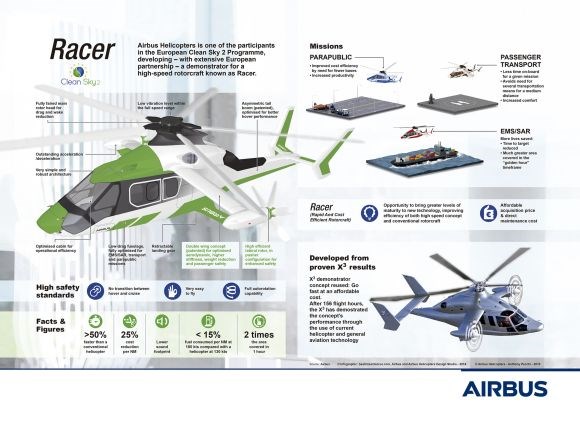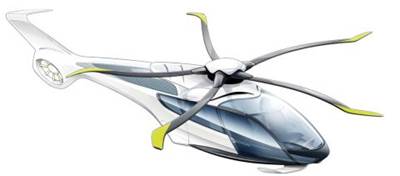Composites and metal vie for fuselage and driveshafts in "Racer" next-gen, high-speed rotorcraft
New compound helicopter demonstrator set to fly in 2020 with hybrid fuselage and flexible metal driveshafts for twin pusher turboprops but will trial carbon composite shafts by 2021.
The program is developing two types of future fast rotorcraft:
- Tiltrotor - generates lift and propulsion from rotors mounted on swiveling engine pods/nacelles on fixed wings or from tilting rotors driven through gearboxes from fixed engines.
- Compound rotorcraft – combines a rotor with a supplementary form of propulsion such as thrust engines or propellers.
The Racer (an acronym for Rapid And Cost-Efficient Rotorcraft) demonstrator displayed by Airbus Helicopters (Merignane, France) at this year’s Paris Air Show (Jun 23-25, Le Bourget Airport) is a compound rotorcraft. Its box-wing design with pusher propellers received a US patent in 2016 and offers performance and safety improvements, according to Airbus Helicopters head of research and technology Tomasz Krysinski.

Racer was developed out of the previous X3 high-speed compound helicopter demonstrator, which set an unofficial speed record of 255 knots (472 km/h; 293 mph) in June 2013. Krysinski says the Racer’s box-wing generates more lift than the X3’s wing-stubs while the box-wing and pusher prop combination reduces power demand by 10% in forward flight.
 The Racer future fast rotorcraft was developed from Airbus Helicopters’ previous X3 model. SOURCE: Airbus Helicopter
The Racer future fast rotorcraft was developed from Airbus Helicopters’ previous X3 model. SOURCE: Airbus HelicopterOne reported goal is to deliver 50% more speed than conventional rotorcraft but at only a 25% cost increase. The Racer is initially designed as a 5-tonne class light helicopter. Aimed at search and rescue, passenger transport and possibly military applications, it will cruise at 190 knots (350 km/h) with much lower fuel consumption than an equivalent conventional helicopter flying at 140 knots. One way it will do this is using an “eco mode” concept for the RTM322 engines which manufacturer (Bordes, France) is testing. This “eco mode” will use an electrically powered “stop and start” of one engine while in cruise to reportedly generate fuel savings of 15% plus a longer range.
Other key features include main landing gear that retract into the Racer’s lower box-wing instead of the fuselage. Wheels can thus be located further apart, allowing a wider footprint for improved stability on the ground and use of simpler retraction and extension mechanisms.
Meanwhile, the Racer’s upper wing-box enables routing of bearingless, flexible driveshafts from the twin RTM322 engines to the propellers. Stiffer than a conventional wing, the box-wing deforms less, which Krysinski says enables simplification of the driveshaft design. He notes that Airbus Helicopters tested the principle of the flexible driveshaft on the X3 but the design has now been optimized in the Racer, both in terms of manufacturing processes and reduced mass. For the planned initial flight in 2020, the driveshafts will be metallic, but a second iteration will use carbon fiber composite driveshafts the following year.
Composites will also be used in the airframe, albeit alongside metal. Airbus Helicopters claims the Racer’s hybrid metallic-composite airframe has been specifically designed for low weight and low recurring costs. According to an , composite specialist Aernnova (Miñano, Spain) will supply the aft fuselage.
Related Content
Plant tour: Collins Aerospace, Riverside, Calif., U.S. and Almere, Netherlands
Composite Tier 1’s long history, acquisition of stamped parts pioneer Dutch Thermoplastic Components, advances roadmap for growth in thermoplastic composite parts.
Read MoreThe potential for thermoplastic composite nacelles
Collins Aerospace draws on global team, decades of experience to demonstrate large, curved AFP and welded structures for the next generation of aircraft.
Read MorePlant tour: Aernnova Composites, Toledo and Illescas, Spain
RTM and ATL/AFP high-rate production sites feature this composites and engineering leader’s continued push for excellence and innovation for future airframes.
Read MoreInfinite Composites: Type V tanks for space, hydrogen, automotive and more
After a decade of proving its linerless, weight-saving composite tanks with NASA and more than 30 aerospace companies, this CryoSphere pioneer is scaling for growth in commercial space and sustainable transportation on Earth.
Read MoreRead Next
Donauwörth as composites pioneer
Airbus Helicopter Germany produces composite primary structure for 30+ years, first all-composite doors for A350 XWB and latest “kinked” composite blades for new “quiet” rotorcraft.
Read MoreCeramic matrix composites: Faster, cheaper, higher temperature
New players proliferate, increasing CMC materials and manufacturing capacity, novel processes and automation to meet demand for higher part volumes and performance.
Read MoreScaling up, optimizing the flax fiber composite camper
Greenlander’s Sherpa RV cab, which is largely constructed from flax fiber/bio-epoxy sandwich panels, nears commercial production readiness and next-generation scale-up.
Read More









